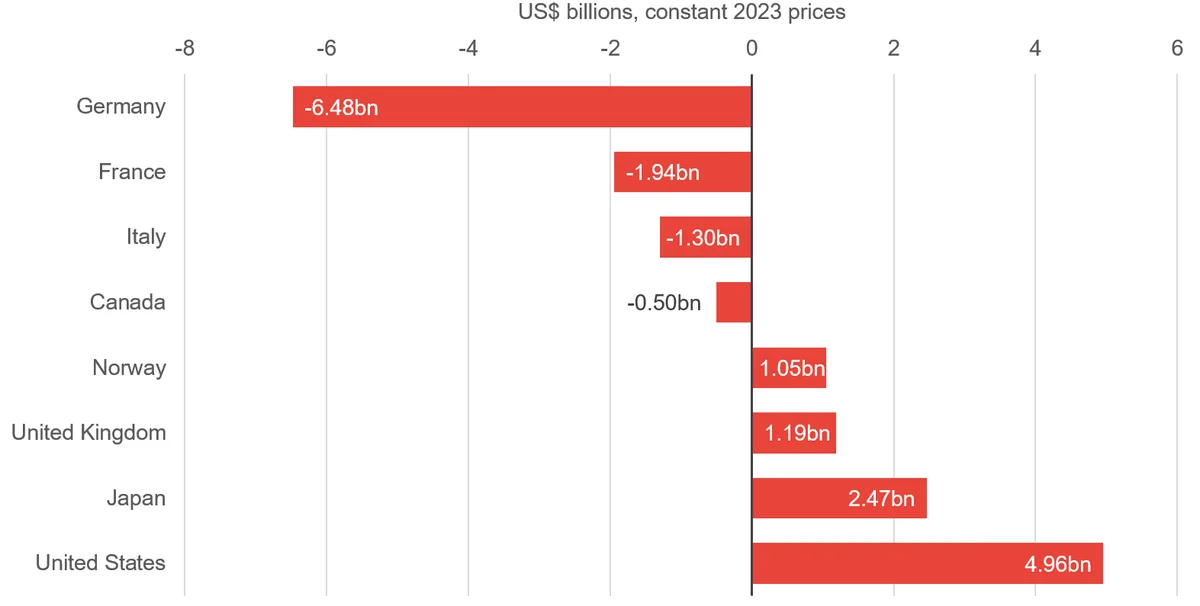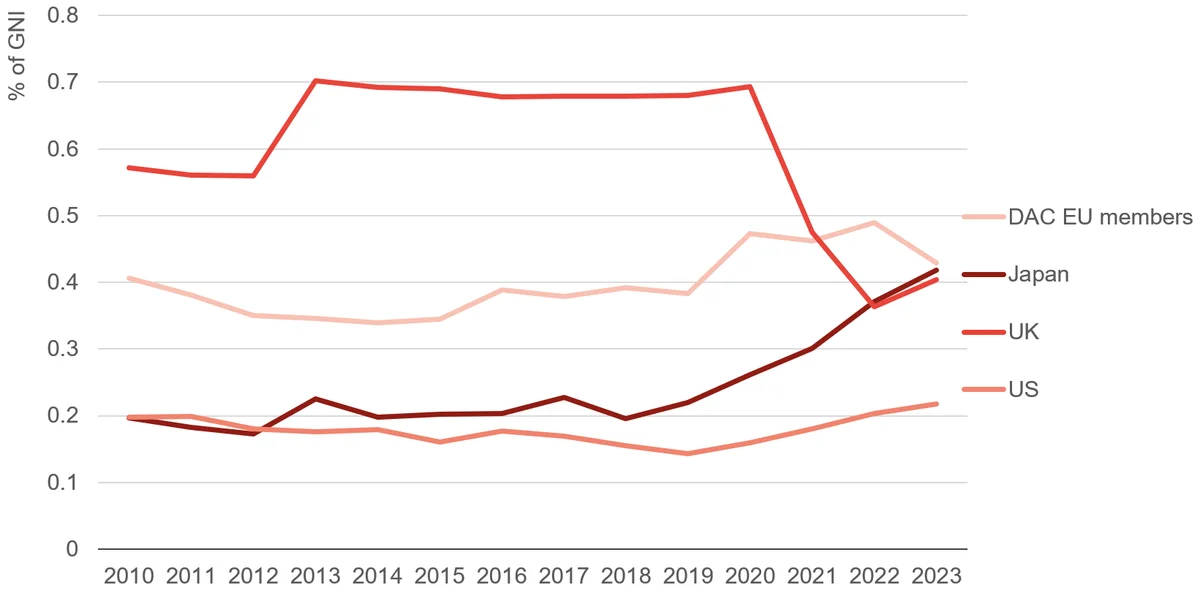Japan and the US offset EU aid squeeze in 2023, but the outlook on aid is poor
New data shows an overall increase in aid in 2023, notably from Japan and the US, but forthcoming cuts from Germany and France may be a sign of worse to come.
Preliminary data from the Organisation for Economic Co-operation and Development's (OECD) Development Assistance Committee (DAC) shows that Official Development Assistance (ODA) remained broadly flat overall in 2023, as increases in aid to Ukraine offset a slight fall in in-donor refugee costs . However, individual donors made some significant changes. Some, notably the US and Japan, saw large increases, while others – particularly in the EU – appear to be stepping away from global leadership on aid. With cuts on the horizon, the outlook is likely to worsen for 2024.
In 2023, ODA increased from US$220 billion to US$224 billion when adopting an official ‘grant-equivalent’ measure in constant 2023 prices. Broadly, this is good news. Net ODA disbursements – a better measure of resources available to partner countries – declined slightly, from US$224 billion to US$222 billion, but only because of a fall in in-donor refugee costs (IDRC). Excluding IDRC, aid remained constant at US$191 billion. Net ODA to both least developed countries (LDCs) and Sub-Saharan Africa also increased, although DAC donors are still far from meeting the UN target of spending 0.15–0.2% of Gross National Income (GNI) on ODA to LDCs . Furthermore, the need for ODA is still outstripping supply , especially in the poorest countries. The focus of ODA remained dominated by support for Ukraine and IDRC, which together accounted for nearly a quarter of the total.
US and Japan fill gap left by EU countries
2023 was not a good year for EU leadership on development. For the bloc as a whole, aid fell by 11% in real terms between 2022 and 2023. While IDRC and aid to Ukraine declined after peaking last year, this was not the reason for the decrease: excluding these categories, aid still fell by 11%, while countries outside the EU saw an increase of 14%. In fact, all but one of the 13 countries to record a decline in aid when IDRC and aid to Ukraine are excluded (Canada) were in the EU. The bloc’s largest donors – Germany and France – recorded declines of 20% and 9% respectively.
Countries with the biggest increases and declines in ODA, 2023

placeholder
Source: OECD DAC Table 1.
Notes: In-donor refugee costs not included in ODA figures.
In stark contrast, Japan’s ODA grew by 15%, whether IDRC or aid to Ukraine are included or not. This is the fifth year of double-digit increases for Japan, which has roughly doubled its ODA since 2019. This is a dramatic turnaround for Japan whose ODA had been stagnant for decades and is seen by some as an attempt to counter China’s influence in the Asia-Pacific region. Japan’s ODA has risen from 0.20% of GNI to 0.42%, and is now comparable to the EU average.
ODA as a % of GNI in Japan, UK, US and DAC EU donors

placeholder
Source: OECD DAC Tables 1 and 2a and 2024 press release.
Notes: In-donor refugee costs not included in ODA figures.
Japan provides a much smaller share of ODA to LDCs than the average among other DAC countries (28% of country-allocable aid compared to 41%), and most of Japan’s aid is provided as loans. Nevertheless, these loans tend to be more concessional than those from EU countries, and the share of both grants and multilateral aid in Japan’s total also increased in 2023.
The United States saw the greatest rise in net ODA in absolute terms, an increase of US$5.0 billion – excluding IDRC – representing 0.22% of GNI by this measure. While low by international standards, this was the highest ODA-to-GNI ratio for the US since 2005, when its aid was inflated by substantial debt relief. Including IDRC, the US spent a greater share of GNI on ODA in 2023 than in any year since the early 1980s. A large part of this increase can be attributed to increased aid to Ukraine, but excluding that, US aid still increased by US$2.7 billion in real terms, or 6%.
ODA boost for some countries may be temporary
The UK and Norway also substantially increased aid, by US$1.2 billion and US$1.1 billion respectively. However, both increases are likely to be temporary. Norway’s aid increase was driven in part by support for Ukraine, but also followed windfalls due to a spike in energy prices , from which Norway benefited as a substantial gas exporter. The UK provided an additional £2.5 billion between 2022 and 2023 to cover a dramatic increase in IDRC, enabling it to exceed its current national target of spending 0.5% of GNI, which is usually treated as a ceiling. But this additional money will no longer be available in 2024 and the UK’s IDRC – driven less by refugees arriving from Ukraine and more by spiralling accommodation costs – will likely remain high, incurring the risk of further cuts to the amount of ODA actually spent in partner countries.
Furthermore, more aid cuts are on the horizon in some of the largest donor countries. Germany is in the middle of an austerity drive and has already indicated that its aid budget will be smaller next year. France has also reportedly cut its aid budget for 2024 and pushed back a commitment to reach the UN target of spending 0.7% of GNI on ODA from 2025 to 2030. Therefore, even if Japan’s double-digit growth continues, a lot is likely to depend on the US if ODA is to remain even at its current insufficient levels. While ODA increased under President Biden, it fell from 0.18% to 0.14% of GNI under Donald Trump. The former president and current Republican nominee has been vocally critical of foreign aid in recent months, highlighting the potential impact of this year’s election on US aid.
As many countries struggle with growing debt burdens and the SDG financing gap continues to widen, ODA will need to increase sharply for the world to have a chance of meeting its development goals, to say nothing of addressing the climate crisis. Currently, there is a substantial risk that ODA will go in the wrong direction, making it all the more important that aid is effective and targeted towards those who need it most.
Related content
How the DAC rules are changing and why you should care
Spiralling emergency accommodation costs from the UK’s Home Office are diverting aid from the world’s poorest
This blog argues that the UK should remove in-donor refugee costs from its aid target to avoid failing the people most in need.
The DAC debates: why aid measurement matters for development
The way we measure aid affects the type and quantity provided as well as our perceptions of it. Why are the DAC's rules controversial?